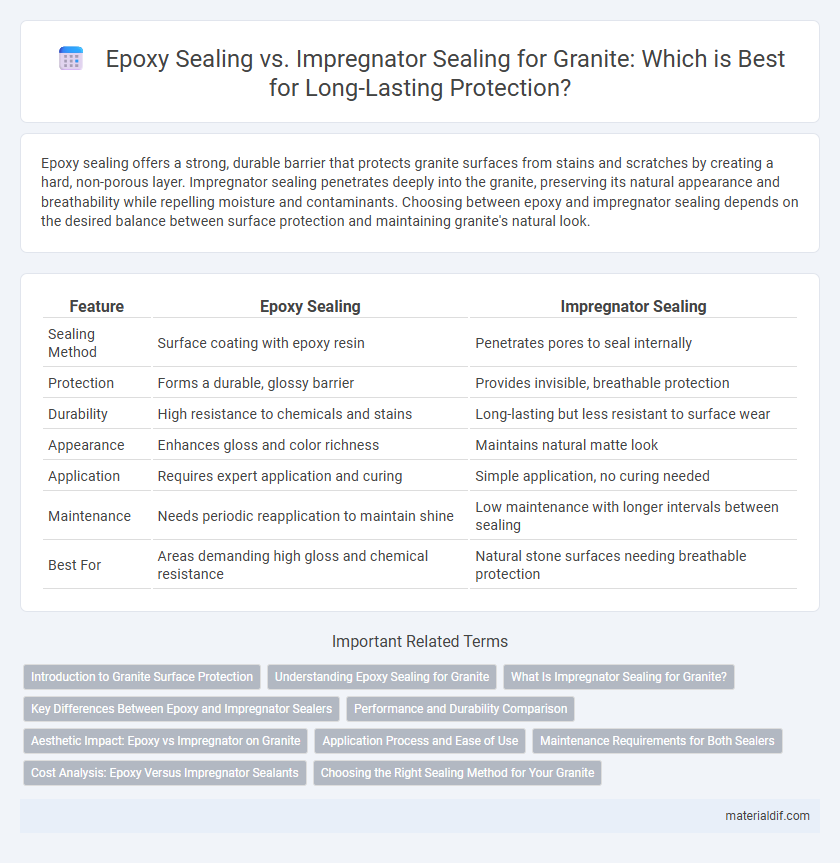Epoxy sealing offers a strong, durable barrier that protects granite surfaces from stains and scratches by creating a hard, non-porous layer. Impregnator sealing penetrates deeply into the granite, preserving its natural appearance and breathability while repelling moisture and contaminants. Choosing between epoxy and impregnator sealing depends on the desired balance between surface protection and maintaining granite's natural look.
Table of Comparison
| Feature | Epoxy Sealing | Impregnator Sealing |
|---|---|---|
| Sealing Method | Surface coating with epoxy resin | Penetrates pores to seal internally |
| Protection | Forms a durable, glossy barrier | Provides invisible, breathable protection |
| Durability | High resistance to chemicals and stains | Long-lasting but less resistant to surface wear |
| Appearance | Enhances gloss and color richness | Maintains natural matte look |
| Application | Requires expert application and curing | Simple application, no curing needed |
| Maintenance | Needs periodic reapplication to maintain shine | Low maintenance with longer intervals between sealing |
| Best For | Areas demanding high gloss and chemical resistance | Natural stone surfaces needing breathable protection |
Introduction to Granite Surface Protection
Granite surface protection involves choosing between epoxy sealing and impregnator sealing based on durability and maintenance needs. Epoxy sealing provides a thick, plastic-like barrier that safeguards against stains and physical damage, making it ideal for high-traffic areas, while impregnator sealing penetrates the stone to repel water and oils without altering its natural appearance. Understanding the specific characteristics and benefits of each sealing method enhances the longevity and aesthetic appeal of granite surfaces.
Understanding Epoxy Sealing for Granite
Epoxy sealing for granite involves applying a resin-based coating that penetrates surface pores to create a durable, waterproof barrier ideal for high-traffic areas and kitchen countertops. This method enhances granite's natural color and gloss while providing superior resistance to stains, oils, and chemicals compared to traditional sealers. Epoxy sealants cure to a hard, glossy finish that protects granite from moisture infiltration and surface damage, extending the lifespan and maintaining the aesthetic appeal of the stone.
What Is Impregnator Sealing for Granite?
Impregnator sealing for granite involves applying a penetrating sealant that soaks deep into the stone's pores, creating an invisible barrier against water, oil, and stains without altering the surface appearance. Unlike epoxy sealing, which forms a hard, protective layer on top of the granite, impregnator sealers preserve the natural look and breathability of the stone while providing long-lasting protection. This method is ideal for maintaining granite's durability and aesthetic appeal in kitchens, bathrooms, and outdoor installations.
Key Differences Between Epoxy and Impregnator Sealers
Epoxy sealers create a durable, glossy surface layer that provides strong resistance to stains, chemicals, and abrasion, making them ideal for heavily trafficked granite countertops and floors. Impregnator sealers penetrate deep into the granite's pores without altering its natural appearance, offering protection against moisture and oil while maintaining breathability. The key differences lie in epoxy's surface coating that may alter texture and appearance, versus impregnator's invisible, internal barrier that preserves the stone's original look.
Performance and Durability Comparison
Epoxy sealing creates a dense, impermeable layer that offers superior protection against stains, scratches, and chemical damage, making it ideal for high-traffic granite surfaces. Impregnator sealing penetrates the granite pores, providing water and oil resistance while allowing the stone to breathe, which enhances durability without altering its natural appearance. Performance-wise, epoxy sealants deliver longer-lasting surface defense but may require professional application, whereas impregnators offer easier maintenance with effective moisture repellency for everyday use.
Aesthetic Impact: Epoxy vs Impregnator on Granite
Epoxy sealing creates a thick, glossy layer that enhances granite's colors and depth, resulting in a vibrant, high-shine finish often preferred for decorative surfaces. Impregnator sealing penetrates the stone, preserving the natural matte or satin appearance while offering subtle color enhancement without altering the granite's texture. For aesthetic impact, epoxy sealing dramatically intensifies visual appeal, whereas impregnator sealing maintains the granite's authentic look with understated enhancement.
Application Process and Ease of Use
Epoxy sealing granite involves applying a resin-based coating that forms a durable, waterproof layer, requiring careful mixing and precise application to avoid uneven surfaces. Impregnator sealing penetrates the granite pores without altering its appearance, offering a simpler application process that typically involves brushing or spraying and allows quicker drying times. Epoxy sealing demands more skill and preparation, while impregnator sealers provide easier, user-friendly maintenance ideal for DIY projects.
Maintenance Requirements for Both Sealers
Epoxy sealing provides a durable, non-porous barrier on granite surfaces, reducing the need for frequent maintenance by preventing stains and moisture penetration. Impregnator sealing penetrates the granite to enhance water and stain resistance without altering the surface appearance but requires periodic reapplication every 1-3 years to maintain effectiveness. Both sealers demand routine cleaning with pH-neutral products, but epoxy coatings typically need less ongoing maintenance due to their stronger protective film.
Cost Analysis: Epoxy Versus Impregnator Sealants
Epoxy sealants for granite typically incur higher upfront costs due to their durable, chemical-resistant properties and complex application process, making them suitable for high-traffic or industrial settings. Impregnator sealants tend to be more cost-effective initially, as they penetrate the granite surface to protect against stains without altering its natural appearance, requiring less labor-intensive application. Over time, epoxy sealants may offer better long-term value through superior protection and reduced maintenance, whereas impregnator sealants might require more frequent reapplications, increasing overall cost.
Choosing the Right Sealing Method for Your Granite
Epoxy sealing offers a durable, glossy finish that provides strong resistance against stains and moisture penetration on granite surfaces, making it ideal for high-traffic areas and kitchen countertops. Impregnator sealing penetrates deep into granite pores without altering its natural appearance, enhancing protection while maintaining breathability and preventing mold growth. Selecting between epoxy and impregnator sealers should consider factors like desired finish, exposure to moisture, and frequency of maintenance to ensure long-lasting granite preservation.
Epoxy Sealing vs Impregnator Sealing Infographic

 materialdif.com
materialdif.com